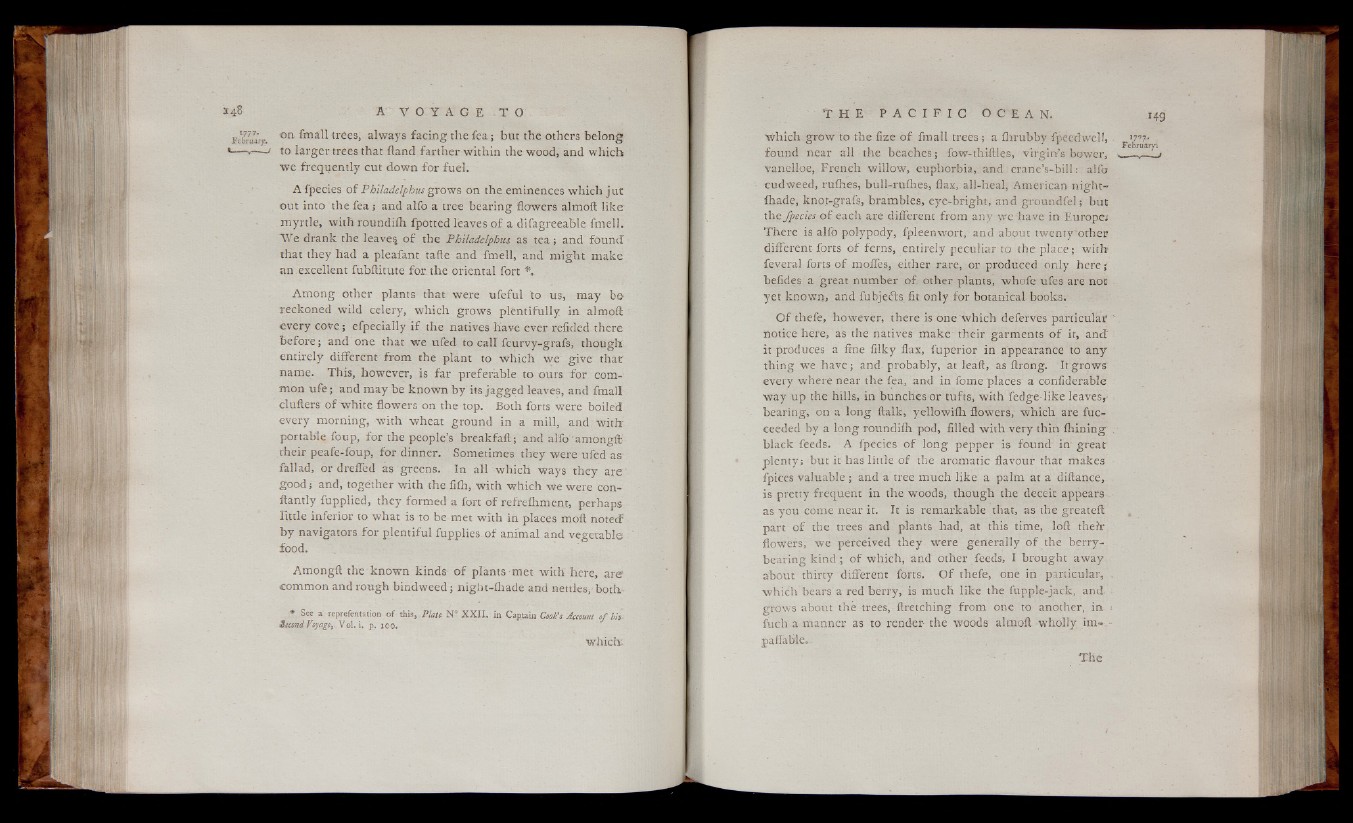
on fmall trees, always facing the fea; but the others belong
to larger trees that Hand farther within the wood, and which
we frequently cut down for fuel.
A fpecies of Philadelphia grows on the eminences which jut
out into the fea ; and alfo a tree bearing flowers almoft like
myrtle, with roundiih fpotted leaves of a difagreeable fmell.
~VVe drank the leaver of the Philadelphus as tea; and found
that they had a pleafant tafte and fmell, and might make
an excellent fubftitute for the oriental fort *.
Among other plants that were ufeful to us, may be
reckoned wild celery, which grows plentifully in almoft
every cove; efpecially if the natives have ever refided there
before; and one that we ufed to call fcurvy-grafs, though
entirely different from the plant to which we give that
name. This, however, is far preferable to ours for common
ufe; and may be known by its jagged leaves, and fmall
clufters of white flowers on the top. Both forts were boiled
every morning, with wheat ground in a mill, and with
portable foup, for the people’s breakfaft; and alfo amongff
rheir peafe-foup, for dinner. Sometimes they were ufed as
fallad, or drefled as greens. In all which ways they are
good; and, together with the liflt, with which we were con-
ftantly fupplied, they formed a fort of refreihment, perhaps
little inferior to what is to be-met with in places moft noted
by navigators for plentiful fupplies of animal and vegetable
food.
Amongft the known kinds of plants met with here, are
common and rough bindweed; night-ihade and nettles,' both
* See a reprefentation o f this, Plate- N° X X I I . in Captain Cook’s Account o f ill:
Second Voyage,. Vol. i. p. too.
which
which grow to the fize of fmall trees; a fhrubby fpeedwell, I g l
found near all the beaches ; fow-thiftles, virgin’s bower, __v——j
vanelloe, French willow, euphorbia, and crane’s-bill: alfo
cudweed, rufhes, bull-ruihes, flax, all-heal, American night-
ihade, knot-grafs, brambles, eye-bright, and groundfel; but
tht fpecies of each are different from any we have in Europe;
There is alfo polypody, fpleenwort, and about twenty other
different forts of ferns, entirely peculiar to the place ; with
feveral forts of moffes, either rare, or produced only here;
befides a great number of. other plants, whofe ufes are not
yet known, and fubjefts fit only for botanical books.
Of thefe, however, there is one which deferves particular '
notice here, as the natives make their garments o f it, and
it produces a fine filky flax, fuperior in appearance to any
thing we have; and probably, at leaft, as ftrong. It grows
every where near the fea, and in fome places a confiderable
way up the hills, in bunches or tufts, with fedge-like leaves^
bearing, on a long ftalk, yellowiih flowers, which are fuc-
ceeded by a long roundiih pod, filled with very thin ihining' .
black feeds. A fpecies of long pepper is found in grear
plenty; but it has little of the aromatic flavour that makes
fpices valuable ; and a tree much like a palm at a diftance, .
is pretty frequent in the woods, though the deceit appears
as you come near it. It is remarkable that, as thè greateft \
part of the trees and plants had, at this time, loft their
flowers, we perceived they were generally of the berry-
beafing kind ; of which, and other feeds, I brought away
about thirty different forts. Of thefe, one in particular,
which bears a red berry, is much like the fupple-jack, and
grows about the trees, ftretching from one to another, in i
fuch a manner as to render the woods almoft wholly im- -
¡gaffa hie..
The